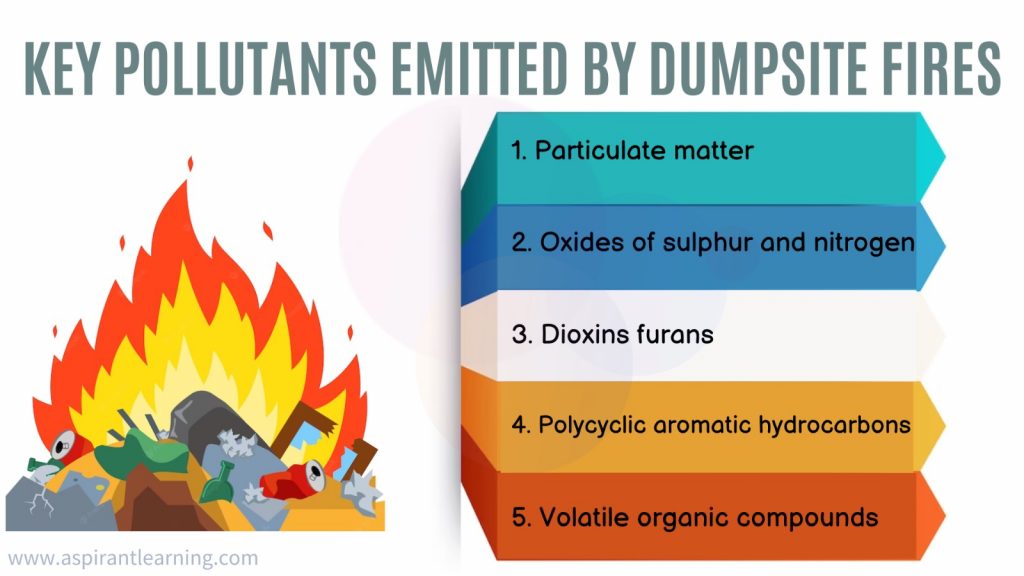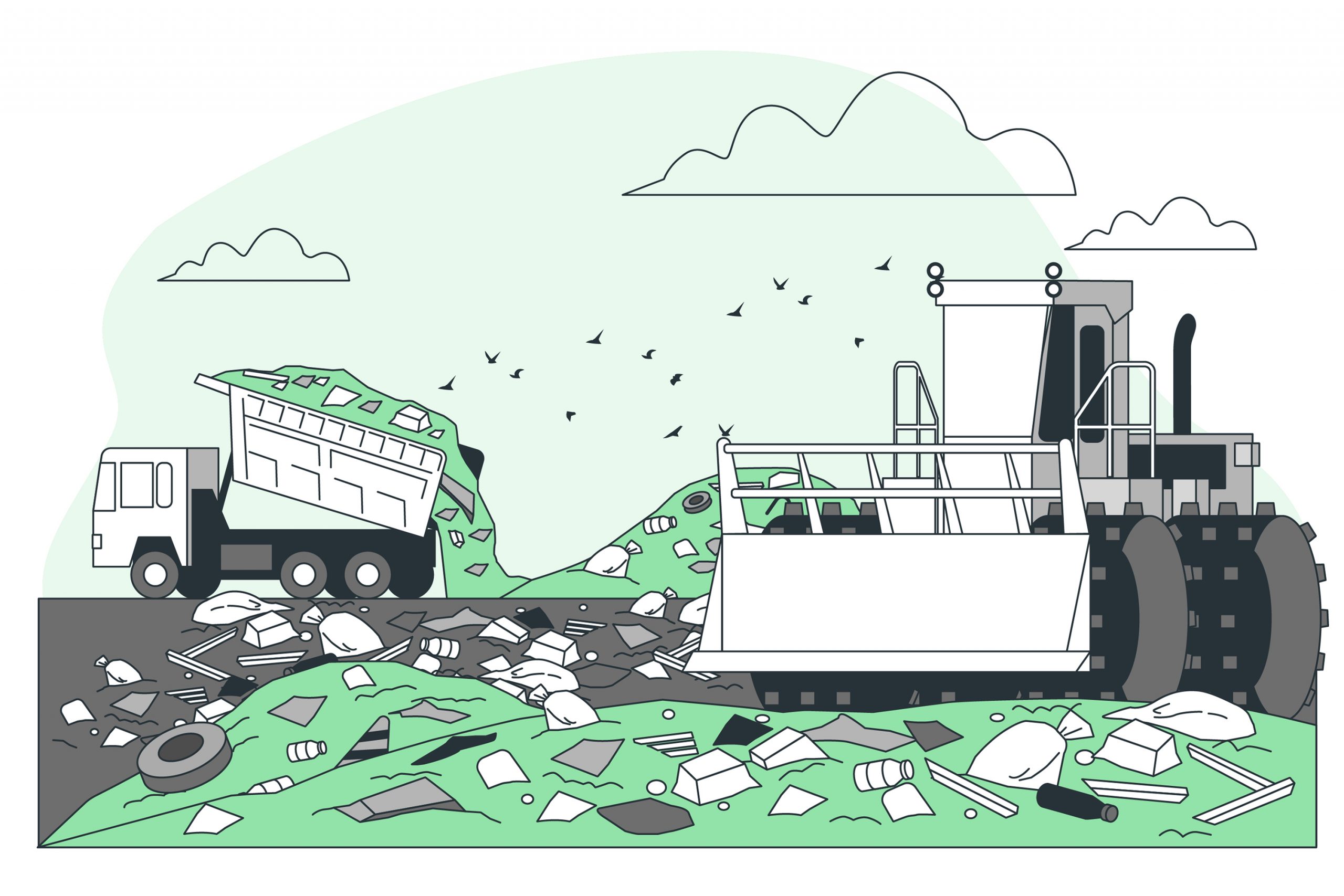News Highlights:
- The Kochi landfill site around Brahmapuram that caught fire earlier this month was a stark reminder that Indian cities must be prepared for more such incidents as summer approaches.
- The fires emit greenhouse gases even as people living around the site were advised to stay indoors and don N95 masks until the fire was put out.
Landfills:
- About
- A landfill site, also known as a rubbish dump, garbage dump, or dumping ground, is a site for the disposal of waste materials.
- It is the oldest and most common form of waste disposal.
- US Environmental Protection Agency (EPA) has established specific guidelines for creating and managing Landfills.
- Solid Waste Management Rules
- In India, landfills are managed under the new Solid Waste Management Rules (SWM), 2016.
- The SWM Rules 2016 mandate that the landfill site shall be 100 metres away from a river, 200 metres from a pond, 500 metres away from highways, habitations, public parks and water supply wells and 20 km away from airports/airbases.

Landfill Fires:
- About:
- A landfill fire occurs when waste disposed of in a landfill ignites and spreads.
- The majority of fires occur on the surface, where fuel and oxygen are in great supply.
- These flames range from one foot below ground to the surface. The other kind can stretch down 40 feet and smoulders underground.
- Types of Landfills:
- Surface landfill fires:
- Surface fires typically occur in underdeveloped countries that lack the capacity to cover the waste with inert daily and intermediate cover adequately.
- Fires can be started by arson, spontaneous combustion, or a dropped cigarette.
- As soon as a fire starts, it must be put out quickly to prevent more damage.
- The employment of heavy machinery to relocate the burning material to a safe location, applying soil to put out the fire, and using suppression agents and firefighting techniques are only a few examples of possible actions.
- Surface garbage burning will produce a sizable amount of poisonous and putrid smoke if nothing is done.
- The waste stream’s composition affects the smoke’s toxicity.
- Subsurface landfill fires:
- Spontaneous combustion or overdrawing a gas collecting system are the two leading causes of subsurface fires.
- These flames are characterised by the fast oxidation of organic waste and tend to burn slowly without apparent flame or copious amounts of smoke.
- Around the extraction well, in the impact zone of the extraction well, or next to a surface feature that permits oxygen to enter the waste mass, the waste material tends to oxidise.
- Elevated temperatures at the wellhead or the finding of soot in the gas collection system are used to identify subsurface fires in gas collecting systems.
- Sometimes, subsurface combustion or oxidation won’t be noticed until a hole forms or smoke rises.
- Usually, a flame is not visible during this type of fire unless the subsurface fire is excavated and exposed to the atmosphere.
- Surface landfill fires:
Reasons behind frequent landfill fires:
- Methane emissions:
- Landfills are the largest source of methane emissions which are highly flammable in nature and play a large role in the ignition of landfill fires.
- The decomposition of waste is largely anaerobic in a landfill, which results in the production of large quantities of methane and carbon dioxide.
- Equipment-related factors:
- Surface fires at dumpsites are also caused by equipment-related factors.
- This includes debris trapped under machines, heat from equipment (exhaust pipes) and welding.
- Human factors:
- Fires are also a result of human factors.
- Waste pickers who scavenge the waste may inadvertently start a fire by smoking in the landfill.
- The temperature of a region:
- The temperature of a region also aids in fire generation.
- For instance, the ongoing heat wave in Delhi enhanced the probability of fire in a landfill.
Problems caused by landfill fires:
- Environmental impact:
- Fire at the Bhalswa landfill site churned out dense plumes of smoke and turned the sky hazy grey, leading to air pollution. Further, there is a release of large amounts of GHG gasses.
- Health impact:
- It causes health ailments in residents living nearby the landfill, like sore throat, itchy eyes and breathing problems.
- Transportation:
- A thick layer of smoke caused by fire impairs the visibility of commuters.
- For instance, Vehicles travelling on the Pallavaram–Thoraipakkam 200 feet radial road (near the Perungudi dump yard) have been experiencing poor visibility since the onset of the fire.
- School Closure:
- It also impacts the nearby schools in the vicinity, which are forced to shut down temporarily in the wake of children’s health.
Reasons for the growth of landfills in India:
- Rising demand for Plastic:
- The rising urbanisation and growing consumer culture in cities have enhanced the demand for packaged goods which has resulted in more plastic usage.
- This plastic gets dumped in landfills and increases its height.
- For instance, the landfill in Bhalswa in the city’s north is taller than a 17-storey building and covers an area bigger than 50 football fields.
- Lack of Capacity:
- At present, India only has 1604 solid waste treatment plants to treat waste capacity.
- These plants are not enough to treat the huge quantum of waste generated in the country, leading to landfill creation.
- Corruption:
- There exists a substantial degree of corruption in Municipal bodies, and in many places, a nexus between the garbage mafia and government officials is also witnessed.
Government initiatives to control landfill fires
- Swachh Bharat Mission-Urban (SBM-U) 2.0 to make all cities Garbage Free by 2026.
- Effective implementation of segregation of waste at source under Solid Waste Management Rules 2016.
- Adopting a zero landfill model based on principles of the circular economy.
- Prepare a city waste management plan
- Swachh Bharat Unnat Bharat Abhiyan
- Plastic Waste Management (PWM) Rules, 2016
- E-waste (Management) Rules, 2016
Way forward:
- The damages caused by landfill fires can be decreased by simply reducing our reliance on landfills. Recycling and composting reduce the amount of waste that has to be transported to landfills.
- The wastes are not segregated, due to which the landfill sites receive mixed wastes, which include organic waste as well as ignitable material and plastics. This area needs to be addressed first so that the source of combustible materials can be eliminated from landfills.
Pic Courtesy: Freepik
Content Source: The Hindu



